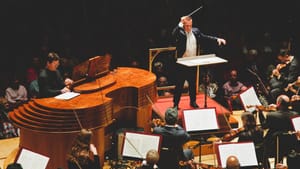Stay in the Loop
BSR publishes on a weekly schedule, with an email newsletter every Wednesday and Thursday morning. There’s no paywall, and subscribing is always free.
Battle of the bands? No, a conversation
Philadelphia Orchestra’s organ concert

Philadelphia’s history with organs is long and impressive. The Wanamaker Grand Court instrument is the world’s largest (28,614 pipes), while the Zimbalist organ installed in the Academy of Music in 1960 was the world’s largest portable organ. And the Cooper Memorial organ in Verizon Hall is the largest mechanical-action concert hall organ in the U.S. Yet organ music never enjoyed as spectacular a presentation in Philadelphia as the Philadelphia Orchestra gave it earlier this month.
Four different organists performed five compositions in partnership with the Orchestra, led by Yannick Nézet-Séguin. Solo organ encores were added for good measure.
When you consider that organs seek to replicate the sounds of orchestral sections, and that the Philadelphia Orchestra has been praised for its organ-like sonorities, you might fear that the two forces could clash with each other, like a pop music “battle of the bands.” Yet Yannick and organist Paul Jacobs displayed admirable give-and-take in their Friday collaboration on Alexandre Guilmant’s Symphony No. 1 for Organ and Orchestra.
Eye-catching attraction
The Guilmant symphony begins with a spikey rhythmic section, then expands with a lush theme that reminds us of César Franck’s popular symphony in D minor (Franck was an organist, too). Throughout, organist and conductor engaged in repeated dialogue, as if two orchestras were conversing with each other.
The middle movement is a dreamy pastorale of ethereal lightness, where the soloist and orchestra reflected each other’s expressions, and the oboe, bassoon, and flute made memorable contributions. In the flashy finale, the brass and the organist pulled out all the stops for an exciting ending. (That cliché about stops, of course, originated as a reference to the knobs that control the volume in pipe organs).
People who think of organ music in churches were amazed to see how cinematic the instrument can be. In addition to its musical rewards, this concert demonstrated how the organ can create an eye-catching stage attraction. The sight of the ten-feet-by-six-feet console with a half-dozen keyboards and its wide array of foot-pedals lends visual appeal for the concertgoer. The instrument is much more photogenic than the console that orchestra audiences normally see perched above and behind the orchestra on the balcony level.
Jacobs, for his part, is best known as the scholarly looking chairman of Juilliard’s organ department, so his showmanship was a pleasant surprise — bobbing and weaving, his legs splaying left and right as he worked the pedals, occasionally throwing his arms in the air as if to say, “Look, ma, no hands!”
(In place of Guilmant’s symphony, Thursday night’s audience heard Joseph Jongen’s Symphonie concertante (with Peter Richard Conte as soloist), while Saturday night’s audience experienced Stephen Paulus’s Grand Concerto for Organ and Orchestra, with Ken Cowan at the organ.)
Something different
Nézet-Séguin wanted to open the program with a composition for organ that was transcribed for orchestra and, naturally, he searched among the many Bach-Stokowski pieces of that genre. The Orchestra’s vice president for artistic planning, Jeremy Rothman, suggested a less-familiar piece written by Dieterich Buxtehude half-a-century before Bach, and Yannick happily embraced that idea. Buxtehude’s Chaconne in E minor was arranged for orchestra in 1937 by Carlos Chávez. The composer’s Mexican nationalism is not evident in this piece, which, instead, makes extensive use of sonorous brasses.
Friday’s concert closed with Edward Elgar’s Enigma Variations, which included the composer’s optional organ reinforcement to the final variation. Elgar wrote that he was amused when he composed these 14 character sketches of people he knew, and Yannick’s interpretation stressed that playful aspect of the piece. In tandem with organist Michael Stairs, Yannick and the Orchestra brought out the personal idiosyncrasies, making the performance a conversational journey through Elgar’s personal profiles.
What, When, Where
Philadelphia Orchestra: Buxtehude-Chávez, Chaconne in E minor; Guilmant, Symphony No. 1 for Organ and Orchestra; Elgar, Variations On an Original Theme (“Enigma”). Paul Jacobs, organist; Yannick Nézet-Séguin, conductor. November 7, 2014 at Verizon Hall, Kimmel Center, Broad and Spruce Sts., Philadelphia. 215-893-1999 or www.philorch.org.
Sign up for our newsletter
All of the week's new articles, all in one place. Sign up for the free weekly BSR newsletters, and don't miss a conversation.

 Steve Cohen
Steve Cohen